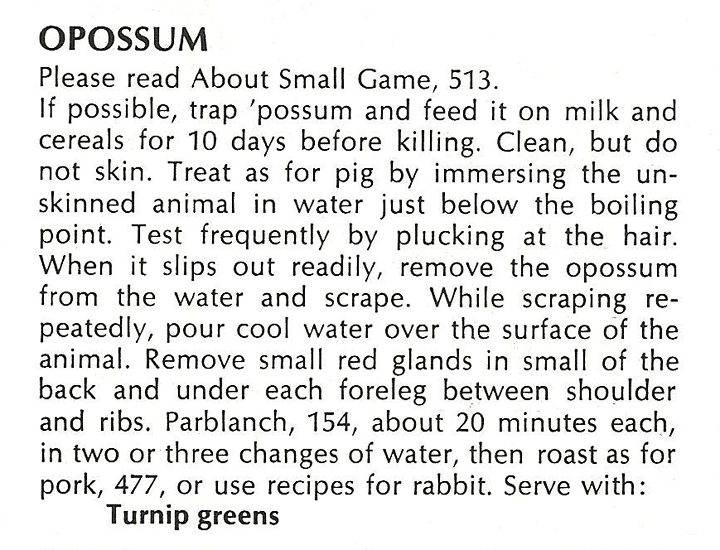People who are paid to postulate upon such matters have theorized that the reason we don’t have herds of brontosauri stomping around in our bayous is due not just to the Alvarez event, but also to egg-eating possums.
You’d think we’d be grateful for this service to our fellow mammals, but as in the case of the dove (which brought Noah the most significant tidal measurements in the history of mankind) possum has been served without apology at meals throughout the South since mankind came down from Canada.
Southern culinary icons tend to be traditional and domestic, the comforting products of home gardens and kitchens. Those game dishes brought in from the woods and fields have in recent years come to play a strikingly diminished role on our tables because fewer people are hunting these days, particularly for sustenance, and while most if not all of you might consider having possum on the table a revolting prospect at best, the simple fact of the matter remains that possums have long been esteemed for their porcine flavor.
One early recommendation comes from John Boynton, a New Englander who came to Mississippi (near Vicksburg) to teach in 1836. Boynton was amazed at the “Old Southwest”, writing to his father, “It would take more than 19 letters to tell you the half of what I’ve seen in one week.” He hunted turkey and deer as well as an exotic animal: “(o)possums by the scores. Had one for dinner today—first rate.”
Faulkner included possum on the Thanksgiving table of the Sartoris family in Flags in the Dust, his first novel to be set in Yoknapatawpha County (called “Yocona”). Written in 1927, the novel is set just after World War I and focuses on the once-powerful, influential and aristocratic Sartoris family contending with decline, but still clinging to the vestiges of affluence. Here’s Faulkner’s description of the meal:
. . . Simon appeared again, with Isom in procession now, and for the next five minutes they moved steadily between kitchen and dining room with a roast turkey and a cured ham and a dish of quail and another of squirrel, and a baked ‘possum in a bed of sweet potatoes; and Irish potatoes and sweet potatoes, and squash and pickled beets and rice and hominy, and hot biscuits and beaten biscuits and long thin sticks of cornbread and strawberry and pear preserves, and quince and apple jelly, and blackberry jam and stewed cranberries.
By far the most solid recommendation for possum comes from Bill Neal, who is widely considered by many to be the dean of Southern cooking, the man who played a key role in raising Southern foods to national prominence and continues to influence new generations of Southern culinarians. In his authoritative Southern Cooking, Neal begins his entry on possum by stating, “All southerners—black, white, or native—who know game relish possum roasted with sweet potatoes. The two components are inseparable; the dish is practically a cultural symbol of regional pride in the piedmont and mountain areas.”
He continues with a recipe from Horace Kephart’s Camp Cookery (1910) that beings: “To call our possum an opossum, outside of a scientific treatise, is an affectation. Possum is his name wherever he is known and hunted, this country over. He is not good until you have freezing weather; nor is he to be served without sweet potatoes, except in desperate extremity.” (The possum season in Mississippi is from October to February.)
The recipe reproduced here comes from another authority, Erma Rombauer’s Joy of Cooking (13th edition, 1975). Note that the recipe recommends “feeding it out” (i.e. capturing the animal before slaughter and feeding it with bland foods not just to provide the meat with a less gamey flavor but purging the possum, which is a notorious scavenger), and while a good Southerner will always serve possum with sweet potatoes, the Rombauers were from St. Louis, which is marginally Southern and urban.



